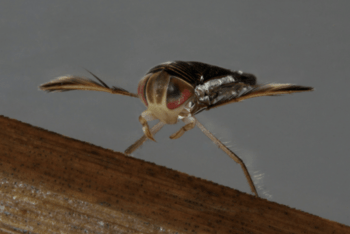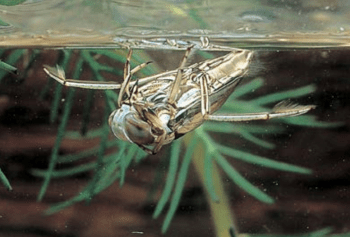
There's nothing quite as good as jumping into your home pool on a hot summer's day for a refreshing swim... until you realise there are some unwelcome guests joining you! Water Boatmen and Backswimmers are common visitors to home swimming pools in the summer months, and an indication that all is not quite well with your pool chemistry.
They are both true bugs, having wings, which means they can fly between pools to find a new home if required, and both can swim and happily live in treated water – which is why they are a problem in the pool. One of them is more of a problem than the other though.

Water Boatmen
Water Boatmen are generally harmless bugs who move about in the water by beating their large paddle-like forelegs. Small - around 12mm fully developed - and brown-ish in colour Water Boatmen swim with their backs facing up and are actually quite good at cleaning up the detritus in your pool. Waterboatmen are omnivorous, meaning they’ll happily eat algae, vegetation and other aquatic species such as mosquito larva, aquatic invertebrates or even small tadpoles. They can live at the edges, on the surface or even at the deepest part of your pool & usually are found where the food sources are. Unfortunately, while generally harmless and unlikely to bite a human, they are an indicator of a pool that is in need of some cleaning and water treatment; the Waterboatmen wouldn’t be there unless there was a food source.
Like Cicadas, Water Boatmen make a sound to attract a mate by rubbing an appendage on a ribbed portion of their abdomen which produces a shrill chirping sound. You may here them in your pool at night.
Backswimmers
Backswimmers on the other hand are less appealing. A little bigger than a Water Boatman - generally around 16-20mm in size - Backswimmers can be identified by the way they swim – on their backs. Their legs face upwards as they scull through the water with their large forelegs.
They have a specially adapted appendage called a rostrum which is a bit like a mouth and nose at the same time. Similar to the one on a mosquito, it is used to inject saliva containing special enzymes into its prey before eating it. Unfortunately, they can use the same appendage to deliver a painful stinging bite to exposed skin and will bite if handled.
Backswimmers can eat almost anything in the pool, but prefer to eat other invertebrates, like our little mate the Water Boatman, mosquito larvae, tadpoles and even small fish or frogs. They are good flyers, so at night they will fly about looking for another body of water. Unfortunately, your pool with its beautiful underwater lights, looks just like a moonlit pond or billabong, so the Backswimmers land there looking for a feed. The good news about Backswimmers is; because they are predatory, they will move off on their own if there is no food available. If you clean your pool and remove the food sources, the Backswimmers will move off as well.
Removing bugs from your pool
Treating your pool for both Backswimmers and Water Boatmen is relatively easy. The Water Boatmen usually appear because there is algae in the pool. Keep the chlorine levels in your pool sufficiently high to break down the algae and add a specialist algicide if needed. No algae equals no food, and no food equals no bugs!
At the first sign of algae, shock dose your pool with chlorine. Then scrub the walls and floor of the pool with your pool brush and turn the filter pump onto its highest setting until the water starts to clear and the chlorine returns to normal levels. A good daily maintenance regime is needed to break the cycle that causes these algae outbreaks; a few minutes skimming the pool to remove any material that has blown or fallen into the pool might be needed and a quick check of the skimmer basket. Also check to see that there is adequate flow through the filter to fully remove the algae from the water.
The addition of a biocide to the pool may be considered if you have large numbers of aquatic invertebrates in your pool, but it is best to check with your pool technician or local pool shop first to ensure you are using the right product.
Thanks to CSIRO and Melbourne Water for the source material used in this article. Melbourne Water produce a great guide to Australian Water Bugs which is free to download here.